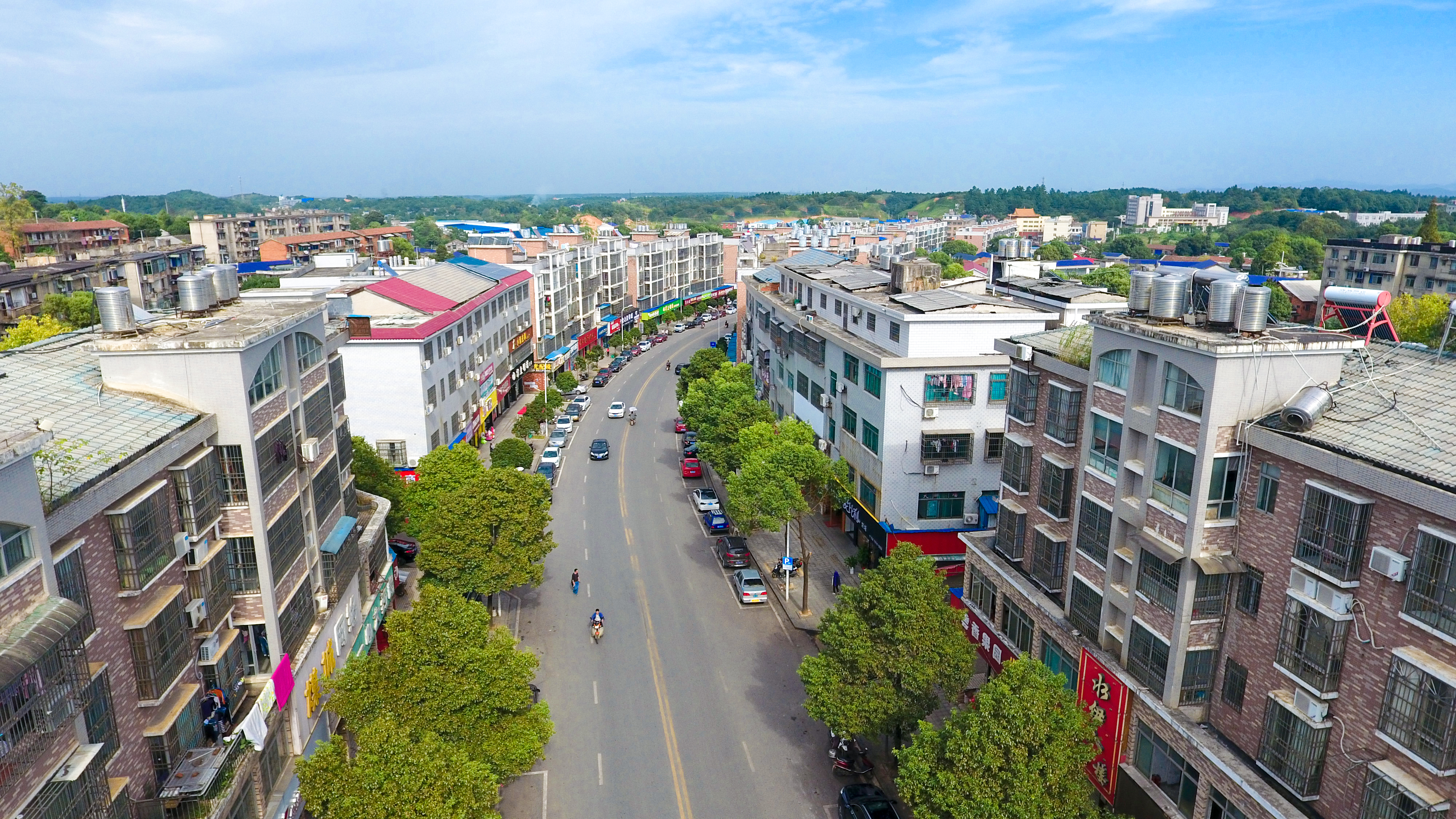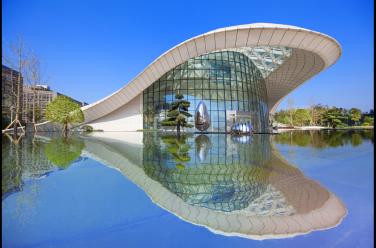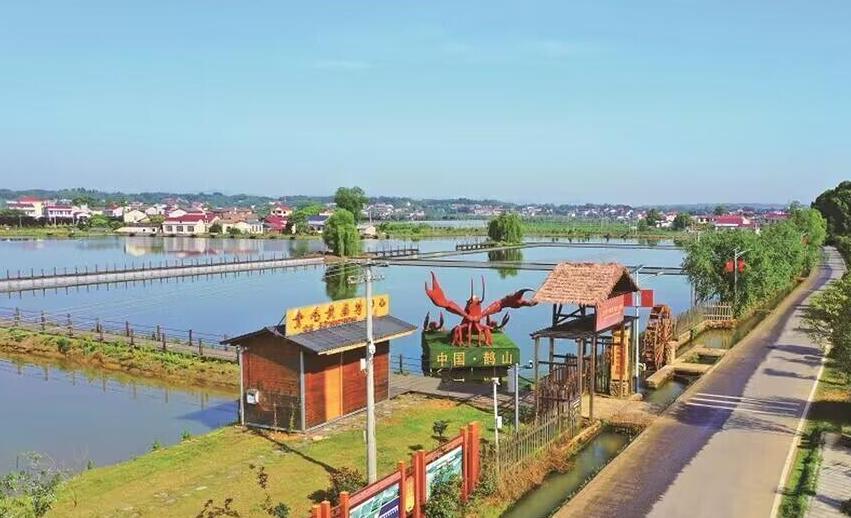Bronze cultural center of Southern China in Ningxiang
Construction has begun on the Tanheli National Archaeological Site Park in Huangcai town, Ningxiang city, Hunan province, which will bring back the Southern China bronze cultural center of 3000 years ago.
The Tanheli park will occupy an area of 23,000 square meters. The Tanheli site is known as the bronze culture center of Southern China because it has been the source of more than 3,000 pieces of unearthed bronze wares from the Shang and Zhou dynasties, including national treasures such as the Four-ram Zun Vessel, a bronze vessel of the late Shang Dynasty, and the Bronze Ding (food container) with human-face design.

The Tanheli Site was named one of the “Top 10 New Archaeological Discoveries in China” in 2004. Because of the discovery, the view that Hunan province is an uncivilized region has been overturned. Tanheli is the most important ancient cultural and historic site of the Shang and Zhou dynasties discovered in Southern China.
A total of one billion yuan is expected to be invested in the Tanheli National Archaeological Site Park, and a planned area of 79.87 hectares will fall within the protection range of the site. The construction of the park includes the Tanheli site protection exhibition hall, the Hunan bronze culture museum, and the ancient civilization experience area. The first phase of the bronze culture museum and the restoration of the city wall will be completed next year and open to the public in the second half of next year.
As the landmark building of the Tanheli National Archaeological Site Park, the Hunan Bronze Culture Museum was designed with reference to the Four-ram Zun Vessel and its shape resembles a square ding vessel. The front entrance of the museum is in a design of a "ding" with the human face design. It is a two-floor building covering an area of 4,000 square meters and will display more than 1,500 bronze wares excavated in Ningxiang and a large number of bronze swords from the Western Zhou period, including over 300 exquisite vessels used for wine containers in the Shang Dynasty.
In addition, Ningxiang has planned the supporting functional areas near the park with an area of 4.2 million square meters as a bronze cultural city with an investment of four billion yuan. The cultural city will include the site park entrance management area, a creative park of Shang and Zhou culture, a folk culture exhibition area, the Qingyang Lake tourist resort area, a food culture area, and an agricultural experience area.
Ningxiang will also set aside 132,500 square kilometers of area for the overall planning of the construction of Huangcai New Town, and make Huangcai town an international tourist destination featuring ancient Shang and Zhou styles.
Four-ram Zun Vessel
The Four-ram Zun is a bronze vessel of the late Shang Dynasty (c. 16th-11th century BC), and it is the largest square Zun among the existing bronze wares of Shang Dynasty in China.
In April 1938, a farmer named Jiang Jingshu in Longquan village, Huangcai town, Ningxiang county was planting sweet potatoes in the mountain when he dug out the Four-ram Zun Vessel, which became a national treasure. It is now in the National Museum of China.
Bronze Square Ding with Human-face Design
The Bronze Square Ding with human-face design was excavated at Zhaizishan, Huangcun village, Huangcai town, Ningxiang county, Hunan province in 1959. It is the only Ding vessel of the Shang Dynasty with a human face design on each of its four sides. It is now in the Hunan Museum.
Since the 1930s, more than 300 bronze wares of the Shang and Zhou dynasties have been excavated from the Tanheli Site in Ningxiang and the surrounding areas, most of them unearthed within a radius of less than two kilometers from the site. Since the unearthed bronze wares of the Shang and Zhou dynasties are all top grade and in large number, they are called Ningxiang bronze wares by the archaeological community, and Ningxiang is also well-known as the hometown of Bronze ware at home and abroad.
In 1994, after further exploration by relevant departments at provincial and municipal levels, the Tanheli Site was believed to have a direct relationship with the bronze wares, which was a breakthrough in uncovering the mystery of Ningxiang bronze wares.
In 2001, with the approval of the National Cultural Heritage Administration of China, a trial excavation was carried out and the remains of a large earthen platform were discovered, which was identified as an ancient cultural site during the Shang and Zhou dynasties.
With the support of the National Cultural Heritage Administration of China, the Hunan Provincial Institute of Archaeology conducted a large-scale excavation of the site for three consecutive years from 2002 to 2004 and discovered and dissected city walls, trenches and a group of noble tombs from the same period, unearthing a further 3,000 bronze wares.
The discoveries of both the foundation sites and city walls of large palaces from the Shang and Zhou dynasties and a large number of ancient tombs in the Western Zhou Dynasty found around the site have proved that the Tanheli is the earliest city site in the Western Zhou period in Southern China, and rare across China.
This discovery was named one of the top ten archaeological discoveries in China for 2004. In 2006, the State Council announced that it was among the sixth group of national key cultural relics protection units. In 2011, it was listed as one of the seven major site protection projects during the "12th Five-Year Plan" period of the National Cultural Heritage Administration of China.
The Tanheli park will occupy an area of 23,000 square meters. The Tanheli site is known as the bronze culture center of Southern China because it has been the source of more than 3,000 pieces of unearthed bronze wares from the Shang and Zhou dynasties, including national treasures such as the Four-ram Zun Vessel, a bronze vessel of the late Shang Dynasty, and the Bronze Ding (food container) with human-face design.

The Tanheli site is known as the bronze culture center of Southern China. [Photo/nxiang.net]
The Tanheli Site was named one of the “Top 10 New Archaeological Discoveries in China” in 2004. Because of the discovery, the view that Hunan province is an uncivilized region has been overturned. Tanheli is the most important ancient cultural and historic site of the Shang and Zhou dynasties discovered in Southern China.
A total of one billion yuan is expected to be invested in the Tanheli National Archaeological Site Park, and a planned area of 79.87 hectares will fall within the protection range of the site. The construction of the park includes the Tanheli site protection exhibition hall, the Hunan bronze culture museum, and the ancient civilization experience area. The first phase of the bronze culture museum and the restoration of the city wall will be completed next year and open to the public in the second half of next year.
As the landmark building of the Tanheli National Archaeological Site Park, the Hunan Bronze Culture Museum was designed with reference to the Four-ram Zun Vessel and its shape resembles a square ding vessel. The front entrance of the museum is in a design of a "ding" with the human face design. It is a two-floor building covering an area of 4,000 square meters and will display more than 1,500 bronze wares excavated in Ningxiang and a large number of bronze swords from the Western Zhou period, including over 300 exquisite vessels used for wine containers in the Shang Dynasty.
In addition, Ningxiang has planned the supporting functional areas near the park with an area of 4.2 million square meters as a bronze cultural city with an investment of four billion yuan. The cultural city will include the site park entrance management area, a creative park of Shang and Zhou culture, a folk culture exhibition area, the Qingyang Lake tourist resort area, a food culture area, and an agricultural experience area.
Ningxiang will also set aside 132,500 square kilometers of area for the overall planning of the construction of Huangcai New Town, and make Huangcai town an international tourist destination featuring ancient Shang and Zhou styles.
Four-ram Zun Vessel
The Four-ram Zun is a bronze vessel of the late Shang Dynasty (c. 16th-11th century BC), and it is the largest square Zun among the existing bronze wares of Shang Dynasty in China.
In April 1938, a farmer named Jiang Jingshu in Longquan village, Huangcai town, Ningxiang county was planting sweet potatoes in the mountain when he dug out the Four-ram Zun Vessel, which became a national treasure. It is now in the National Museum of China.
Bronze Square Ding with Human-face Design
The Bronze Square Ding with human-face design was excavated at Zhaizishan, Huangcun village, Huangcai town, Ningxiang county, Hunan province in 1959. It is the only Ding vessel of the Shang Dynasty with a human face design on each of its four sides. It is now in the Hunan Museum.
Since the 1930s, more than 300 bronze wares of the Shang and Zhou dynasties have been excavated from the Tanheli Site in Ningxiang and the surrounding areas, most of them unearthed within a radius of less than two kilometers from the site. Since the unearthed bronze wares of the Shang and Zhou dynasties are all top grade and in large number, they are called Ningxiang bronze wares by the archaeological community, and Ningxiang is also well-known as the hometown of Bronze ware at home and abroad.
In 1994, after further exploration by relevant departments at provincial and municipal levels, the Tanheli Site was believed to have a direct relationship with the bronze wares, which was a breakthrough in uncovering the mystery of Ningxiang bronze wares.
In 2001, with the approval of the National Cultural Heritage Administration of China, a trial excavation was carried out and the remains of a large earthen platform were discovered, which was identified as an ancient cultural site during the Shang and Zhou dynasties.
With the support of the National Cultural Heritage Administration of China, the Hunan Provincial Institute of Archaeology conducted a large-scale excavation of the site for three consecutive years from 2002 to 2004 and discovered and dissected city walls, trenches and a group of noble tombs from the same period, unearthing a further 3,000 bronze wares.
The discoveries of both the foundation sites and city walls of large palaces from the Shang and Zhou dynasties and a large number of ancient tombs in the Western Zhou Dynasty found around the site have proved that the Tanheli is the earliest city site in the Western Zhou period in Southern China, and rare across China.
This discovery was named one of the top ten archaeological discoveries in China for 2004. In 2006, the State Council announced that it was among the sixth group of national key cultural relics protection units. In 2011, it was listed as one of the seven major site protection projects during the "12th Five-Year Plan" period of the National Cultural Heritage Administration of China.

 Ningxiang listed on China’s top 100 counties with comprehensive competitiveness
Ningxiang listed on China’s top 100 counties with comprehensive competitiveness  College welcomes a student of courage
College welcomes a student of courage  Changsha Blue Moon Valley Intelligent Home Appliances Industrial Town
Changsha Blue Moon Valley Intelligent Home Appliances Industrial Town  This is Ningxiang High-tech Zone
This is Ningxiang High-tech Zone 





